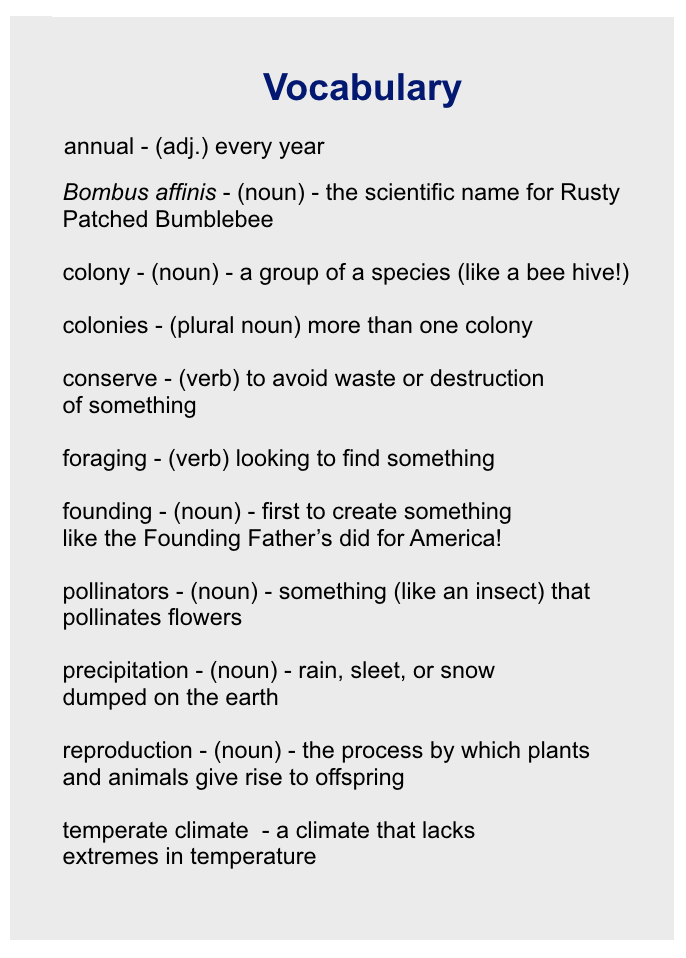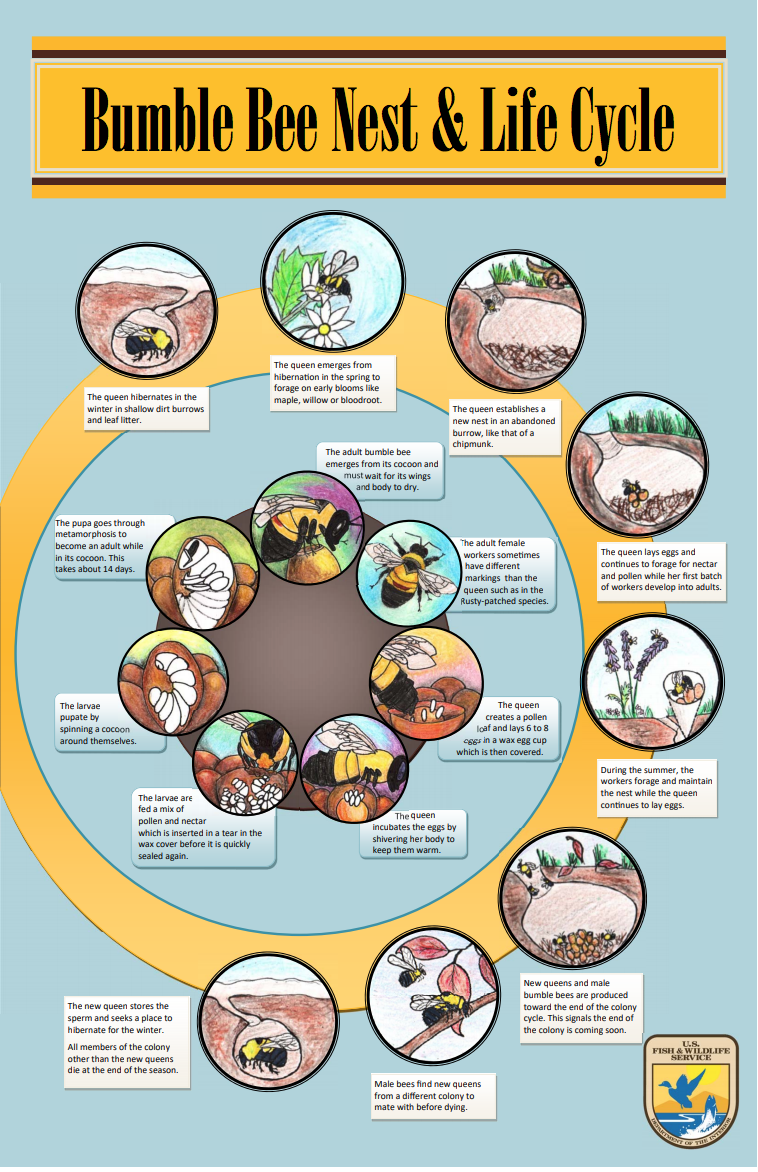All About The Rusty Patched Bumblebee!
Rusty Patched Bumblebees don’t make honey but that doesn’t mean they don’t help pollinate things we love to eat! Do you like blueberry muffins or do you sometimes enjoy a glass of apple juice? How about tomato sauce on pizza? Bumblebees are some of the most important pollinators of crops such as blueberries, cranberries, and apples and almost the only insect pollinators of tomatoes. Bumblebees are better pollinators than honeybees for some crops because of their ability to “buzz pollinate.” What is buzz pollination? It’s when bees move their flight muscles rapidly, causing the flower and anthers to vibrate, dislodging pollen.(2) Way to go Rusty Patched Bumblebee!
The Rusty Patched Bumblebee used to be commonly found from the upper Midwest to the eastern seaboard. In recent years, however, it has disappeared from more than three fourths of its historic range. In 2017 the Rusty Patched Bumblebee was listed as an endangered species. Today, the Rusty Patched Bumblebee’s population has declined by ninety-five percent.
Source: US Fish and Wildlife Service. CLICK HERE to view their awesome RPB Range Map!
The Life Cycle of the Rusty Patched Bumblebee
Reproduction
Rusty Patched Bumblebee colonies have an annual life cycle. In spring, the queens emerge from diapause, which is a form of hibernation, and find nest sites. The queens collect nectar and pollen from flowers and begin laying eggs. Workers hatch from these first eggs. Colonies grow as workers collect food, defend the colony, and care for the young. Queens stay in the nests and continue to lay eggs. From mid-July through September, new queens and males also hatch from eggs. The males leave the colony to mate with new queens from other colonies. In fall, the founding queens, workers and males die. Only new queens go into diapause over winter. The Rusty Patched Bumblebee life cycle begins again the next spring. (1)
Colonies
Rusty Patched Bumblebees (which are called Bombus affinus by scientists), live in colonies consisting of a single queen, female workers, and males. Colony sizes of Rusty Patched Bumblebees are large compared to colonies of other bumblebees. Healthy Rusty Patched Bumblebee colonies may consist of up to 1000 individual workers. Queens are the largest bees in the colony, and workers are the smallest. All Rusty Patched Bumblebees have completely black heads. But only workers and males have a rusty reddish patch in the center of their backs (1).
Ben’s note: Why are we using this not so amazing sketch of a Rusty Patched Bumblebee colony instead of a photo? Because RPB colonies are now so rare we don’t know ANYONE who has one. If you could send us a better illustration so we can put it here we would be very grateful!
Habitat
The Rusty Patched Bumblebee has been found in many kinds of habitats, including prairies, woodlands, marshes, farms, and parks and gardens (2) Bumblebees need places to live that provide nectar and pollen from flowers. The nectar from flowers provides carbohydrates and the pollen provides the Rusty Patched Bumblebee with protein. The number of queens that a colony can produce is directly related to the amount of pollen that is available.(2) Bumblebees search for these ‘food flowers’ less than one kilometer from their nesting site.(2) It is important that bumblebee habitat have plenty of food sources nearby. The Rusty Patched Bumblebee is one of the first species to be seen early in the spring and the last to go into diapause in the fall. In other words, the Rusty Patched Bumblebee lives a long life (for an insect anyway)! So, to find enough food to survive, the Rusty Patched Bumblebee needs flowers that are in bloom during their long life cycle, from April through September. Many of these flowers can be found in the prairie. But many of the first flowers to bloom in spring are found near woodland habitats. (2) Rusty Patched Bumblebees also need underground cavities, such as mouse burrows, or clumps of grasses for nesting sites. To hibernate over the winter, queens need undisturbed soil.
Climate
Rusty Patched Bumblebees live in temperate climates. Rusty Patched Bumblebees cannot survive long periods of high temperatures ( 95° Fahrenheit (F) or 35° Celsius). Rusty Patched Bumblebees can fly in cool temperatures and low light levels unlike other bees. This ability helps them extend their daytime foraging times to find enough food. (2) Plants also are affected by temperature and precipitation. The flowers that the Rusty Patched Bumblebee needs to survive also need certain temperatures and rainfall to survive. Lack of rain, or drought, can decrease the number and types of flowering plants in an area. Less plants means less food for the Rusty Patched Bumblebee.(2)
Why conserve Rusty Patched Bumblebees?
As pollinators, Rusty Patched Bumblebees help to fertilize our food supply and ensure the healthy functioning of our ecosystems. Bumblebees are keystone species in most ecosystems. (What’s keystone species? That’s a species other species depend on in an ecosystem. So much so that if you remove a keystone species from an ecosystem that ecosystem changes dramatically). The Rusty Patched Bumblebee helps to pollinate native wildflowers. Rusty Patched Bumblebees also to pollinate the plants that create seeds and fruits that feed animals like songbirds and grizzly bears.
Footnotes
1. RPB Fact Sheet, US Fish and Wildlife Service
2. Rusty Patched Bumble Bee (Bombus affinis) Species Status Assessment Final Report, June 2016
3. In order to release the pollen, bees that can buzz pollinate are able to grab onto the flower and move their flight muscles rapidly, causing the flower and anthers to vibrate, dislodging pollen. Pollination involving vibrations is called buzz pollination Buzz Pollination - Wikipedia
Written by Jesse Semeyn and Colleen McVeigh. Thank you Jesse and Colleen!






